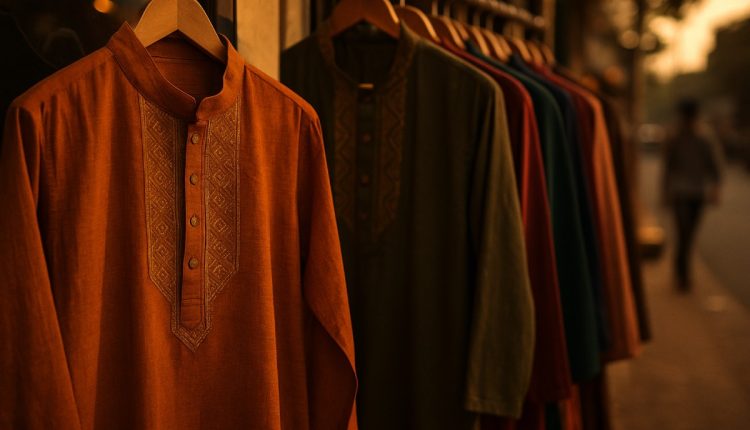The kurta is more than just a traditional garment—it’s a cultural emblem that has stood the test of time. From royal courts to college campuses, from festive celebrations to everyday comfort, the kurta blends heritage with contemporary flair. Whether it’s for men or women, the kurta is an effortless expression of ethnic elegance.
What is a Kurta?
A kurta is a long, straight-cut upper garment traditionally worn in the Indian subcontinent. It is usually collarless or has a mandarin collar, and comes in various lengths, fabrics, and styles.
-
For men: Often paired with pajamas, churidars, jeans, or even dhotis.
-
For women: Styled with leggings, palazzos, skirts, or shararas.
Fabric Types and Seasonal Picks
Kurtas adapt beautifully to India’s diverse climate and occasions. Here’s a quick breakdown:
Summer Kurtas
-
Fabric: Cotton, linen, mulmul
-
Style: Light prints, pastel shades, short or knee-length
-
Occasions: Casual, office, daily wear
Monsoon Picks
-
Fabric: Blends of cotton-silk or synthetic to dry faster
-
Colors: Earthy tones, florals, minimal embroidery
-
Occasions: Work and outings
Winter Styles
-
Fabric: Wool-blend, khadi, velvet, heavier cottons
-
Add-ons: Pair with Nehru jackets or shawls for layering
-
Occasions: Festivals, weddings, evening wear
Kurta for Men & Women: Style Breakdowns
Men’s Kurta Styles
-
Pathani Kurta – With pockets and a shirt-style collar. Bold and masculine.
-
Short Kurta – Perfect for casual jeans-and-sneakers look.
-
Chikankari Kurta – Elegant embroidery, great for Eid or celebrations.
-
Silk Kurta – For weddings and festive occasions.
Women’s Kurta Styles
-
Anarkali Kurta – Flowy, flared, and dramatic.
-
Straight Cut Kurta – Ideal for formal and daily use.
-
A-Line Kurta – Stylish and flattering, suitable for all body types.
-
Asymmetrical Kurta – Modern twist with fusion aesthetics.
Prints, Patterns & Embellishments
Kurta designs are a canvas for India’s rich textile traditions:
-
Block Prints – From Rajasthan’s Bagru to Gujarat’s Ajrakh.
-
Embroidery – Chikankari (Lucknow), Kantha (Bengal), Phulkari (Punjab).
-
Digital Prints & Tie-Dye – Popular in Indo-western fashion circles.
Where to Shop the Best Kurtas
Whether you’re looking for affordable everyday wear or luxurious designer pieces, kurtas are available everywhere:
-
Offline: FabIndia, Manyavar, Lifestyle, Biba, Global Desi
-
Online: Myntra, Ajio, Taneira, Jaypore, Amazon
Tip: Look for handloom labels or artisan-made tags to support local weavers.
How to Accessorize Your Kurta Look
For Men:
-
Footwear: Kolhapuris, mojaris, or juttis
-
Add-ons: Nehru jackets, brooches, pocket squares
For Women:
-
Jewelry: Oxidized earrings, bangles, nose rings
-
Scarves/Dupattas: Cotton for casual, silk or banarasi for weddings
Occasions to Flaunt a Kurta
| Occasion | Men’s Pick | Women’s Pick |
|---|---|---|
| Office Wear | Short cotton kurta | Straight-fit kurta |
| Festivals | Silk kurta + jacket | Anarkali with dupatta |
| College/Casual | Printed short kurta | A-line printed kurta |
| Wedding Guest | Embroidered kurta | Floor-length kurta |
Why the Kurta is Here to Stay
The kurta’s versatility, comfort, and cultural pride make it a staple in Indian wardrobes—and increasingly, in global fashion circles too. With rising demand for sustainable, ethnic fashion, the kurta checks all boxes. It’s not just a garment—it’s a statement of identity and style.
Final Thoughts
A kurta isn’t bound by gender, age, or trend. It’s timeless, expressive, and ever-evolving. Whether you’re dressing up for Diwali or heading to a casual brunch, a well-styled kurta will never let you down. So go ahead—layer it, dress it up, or wear it solo—just don’t forget to wear it with pride.


Comments are closed.